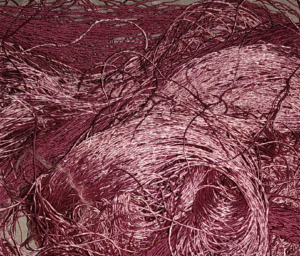Well, that was probably a bit cryptic. So. Let me explain. About... silk.
As you probably know, most silk used in the Middle Ages was reeled, not spun - the long filaments from several cocoons wound off said cocoons together to get you a thread of silk. The more cocoons, the thicker your thread.
When the silkworm makes the cocoons, they're for its protection - so they are pretty hard. That's caused by sericin, or silk gum, which is more or less a protein-based glue sticking the filaments together and hardening them into a nice, protective shell. Hot water softens the sericin so the cocoons can be reeled off (it also kills the silkworm). The glue stays on, though, getting you... gummy silk, or raw silk.
This raw silk is stiff and can feel like a stiff nylon thread, very un-like the soft silk that we know today... because modern silk is usually completely de-gummed.
The thing about de-gummed silk? If you don't twist it, it is very fragile and prone to snagging. It's hard to handle altogether (though yes, very soft and shiny). Since talking to a conservator friend years ago who told me that usually, medieval silks have a much firmer structure than modern ones, I've been wondering about the use of gummy or partially gummy silk in history. The more recent research about the Albecund band is making me more and more convinced that gummy silk would be the solution to a few of the issues with weaving such a band.
One of the questions in that regard was - how does dyeing gummy silk work? Will it dye well? And will the dye be fast? (Side question - what happens if you de-gum it after dyeing?)
Well, I've gotten back two skeins that were test- dyed together, as in both mordanted and dyed together.

The gummy silk took on the colour much, much better... isn't that fascinating?